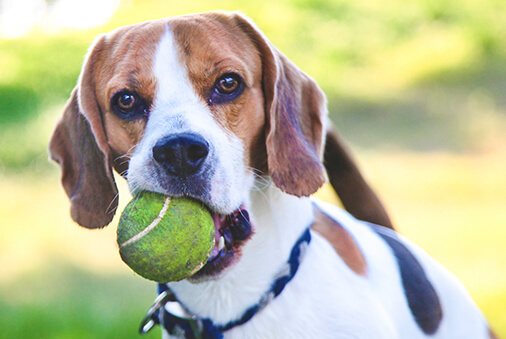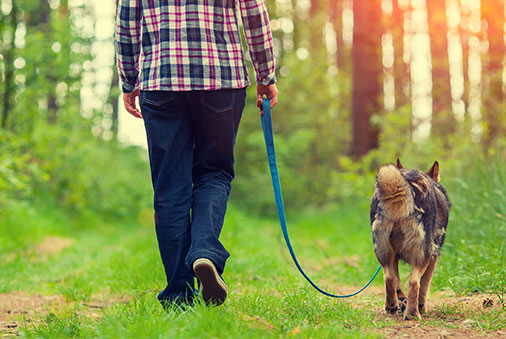8 to 12 Weeks | 3 to 6 Months | 7 to 12 Months
Welcome Home Puppy
Hopefully, you’ve had the chance to puppy-proof your home before the new arrival. Simple things like locking trash bins, hiding electrical cords, stowing small ingestible items away, and installing child-proof latches on lower cabinets can help keep your pup out of harm’s way.
Safe chew toys are paramount and will remain a staple throughout your dog’s life, so have plenty on hand. Careful, they’re easy to trip over.
You’re now the leader of this pack who needs to guide your pup, especially during this time of frequent distractions and active exploration in his new environment. Developmental changes will happen fast so here’s what to watch out for during these first few months.
Good Puppy Health Starts Here
Vet visits & vaccinations
Your puppy’s health is paramount so be sure to keep up with vet appointments. Since your puppy’s immune system isn’t fully developed until he/she’s about three months old, vaccines are seen by most veterinarians as imperative.
Check with your veterinarian for their guidance regarding initial vaccines.
Pups usually get a combination vaccine, DHPP, to protect against distemper, canine hepatitis, parainfluenza, and parvovirus.
Your vet may also recommend:
• Leptospirosis vaccination
• Bordetella (kennel cough) vaccine
• Lyme Disease vaccine.
After vaccinating, watch for possible, though rare, allergic reactions. Contact your vet immediately if your pup exhibits:
• Signs of swelling
• Loss of consciousness
• Seizures
• Hives
• Difficulty breathing
• Disorientation or clumsiness
Ask your veterinarian how soon you can have play dates with other dogs since it can take days to weeks for the vaccinations to fully protect your pup.
You may want to start Heartworm prevention treatments before your pup is six months old, as well. Check with your veterinarian to help decide what’s right for your pet. Also you can read what others say about vaccines and heartworm prevention on helpful sites like PetMD.com.
Healthy Feeding for Your Puppy
Three to four meals a day
Puppies are usually weaned at five to seven weeks old. By the time you bring yours home, he should be eating solid food that’s specially formulated for puppies.
At first you’ll probably continue with the same food and feeding schedule the breeder or adoption center started but after your pup’s been home a week or so it’s time to reevaluate the quality and quantity of his diet and continue evaluating it every few weeks.
Ask your veterinarian or adoption center professionals for recommendations and be sure to stick with high-quality puppy food that provides wholesome nutrition, like BLUE.
Depending on their body mass, puppies need more calories and essential nutrients than adult dogs, so three or four meals a day is typical when pups are less than six months old. Don’t forget water! It’s important that your pup stays well hydrated.
As your puppy grows, you can make food portions a bit bigger but avoid raising a chowhound, especially with breeds that love to eat, like Labradors. Also, just because you have a large breed puppy, doesn’t mean it needs more food.
On the contrary, overfeeding can cause larger breeds to gain excess weight prematurely. Check with your vet for the best way to feed these bigger pups. Regular vet check ups will help you keep your puppy’s weight on track.
Fat check
Check your puppy’s body condition every week: If his rib cage is visible and his pelvic bones stick out, your pup is probably too thin. If layers of fatty skin obscure his ribs and there’s fat at the base of his tail, it’s diet time.
- Puppies’ abdomens should tuck up
- Ribs should be defined and palpable without thick layer of skin
Starting Puppy Dental Care
Warning: Teeth ahead
As your pup’s permanent teeth grow in, he’ll want to chew everything. Remember, chew toys will become his (and your) best friend for curbing open season on favorite household items.
Just as babies teethe, your pup will be trying out his new chompers, so biting is common at this stage. Nipping is also the way he naturally learned to play with his littermates and control the strength of his bites; if he bit too forcefully, his siblings would stop playing with him.
It’s your turn to do the same thing: Ignore him and walk away when he nips too hard. Scolding your pup still gives him attention so the best way you can teach him to control his bites is to stop interacting with him.
As with all puppy lessons, repetition is key. He’ll soon learn that when he bites he loses contact with you, which will help modify his behavior.
Healthy Sleep for Your Puppy
Plenty of Shut-Eye
Catching Frisbees® may not be your pup’s favorite activity yet, but catching zzzzzs should be. Keep playtimes short and naptimes long by making sure he has plenty of down time.
Setting specific times to take your pup out at night will help him get used to a schedule that’s optimal for sleep. Some pet parents have found a ticking clock by their puppy’s bed can also help him fall asleep faster and longer.
Furry Bedfellows
As with children, avoid letting your puppy sleep in your bed no matter how much they cry those first few nights at home. Otherwise, it will be that much harder to get him to sleep in his own bed and you could end up with a furry sleep mate for life.
Start Training Your Puppy
A Den of One’s Own
Just as their wolf ancestors had dens, puppies will seek out a place that’s safe and secure.
You can recreate the perfect den-like atmosphere with a crate, especially if you cover three sides of it with a blanket to help your pup sleep even better. Crates are also a training must-have that help curb many “NO!” behaviors such as: chewing family shoes, tearing up sofa cushions, laying on beds and, of course, potty mishaps.
Crating Tips
-
Put the crate in a visible area where the family gathers so your pup won’t feel abandoned.
-
Coax your pup into his new den with a treat; give him plenty of time to explore the crate and feel comfortable.
-
Put a puppy bed, some old blankets and his favorite chew toys in his crate.
-
Reward your pup with lots of petting and a treat or two when he uses the crate on his own.
-
Close the crate door a bit longer each time, so your pup can adjust to being alone for longer intervals.
-
Whining? Resist opening the door unless he continues for a while and you believe something is physically wrong. It’s normal for your little guy to whine at first but it’s better that he acclimates to his den while he’s young than when he’s an older dog who can’t be taught new “tricks”.
Puppy pre-school
Due to his nascent immune system, it’s too soon for your pup to engage in formal training classes and public socialization, but it’s very important to introduce him gradually to a variety of people in the security of your own home.
This is also the time to introduce your pup to a collar and start teaching him to follow on a leash and to come when called. Each pre-training sessions should be as fun as possible (lots of treats and positive reinforcement) and last about three minutes.
Prepare for housebreaking by taking trips outside every hour: after your pup eats, drinks, plays, and wakes up. He won’t have complete control of his bladder and intestines until he’s about three months old but it’s wise to start the process sooner than later.
Common concerns
Is your pup skittish? Shying away from sudden movements and loud noises is normal at this stage; naturally, never force your pup to do something he adamantly resists.
Learn more about the next important stage in your puppy’s life.





